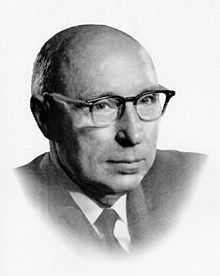Gordon Shrum
| Gordon Shrum | |
|---|---|
 | |
| Chancellor of Simon Fraser University | |
| In office 1963–1968 | |
| Personal details | |
| Born | Gordon Merritt Shrum January 14, 1896 Smithville, Ontario |
| Died | June 20, 1985 (aged 89) Vancouver, British Columbia |
| Alma mater | Victoria College |
Gordon Merritt Shrum OC OBE MM (January 14, 1896 – June 20, 1985) was a Canadian scientist, teacher, administrator, and the first Chancellor of Simon Fraser University.[1]
Life and career
Shrum was born in Smithville, Ontario, the son of Emma Jane (née Merritt) and William Burton Shrum. His education at Victoria College at the University of Toronto, where he started in 1913, was interrupted by World War I. A friend of Lester (Mike) Pearson, he was in his Canadian Officers Training Corps (C.O.T.C.) unit starting in 1914. Their company commander was Vincent Massey.
On April 1, 1916, he enlisted in the army. He was a gunner and fought at the Battle of Vimy Ridge. He received the Military Medal during the war. After the war, he continued his education and received a Bachelor of Arts in 1919, a Master of Arts in 1921. As a doctoral student in February 1923 he was the first to replicate Kamerlingh Onnes's 1908 Nobel Prize–winning feat of liquefying helium.[2] Later that year he was awarded his Doctorate in physics for studies of the hydrogen spectrum. As a post-doctoral fellow he was the first to identify the prominent green line in the Aurora Borealis as due to oxygen.
In 1925, he joined the faculty at the University of British Columbia (UBC) where he taught physics. In 1935 he was elected a Fellow of the Royal Society of Canada. From 1938 to 1961, he was the head of the Physics Department. From 1957 to 1961, he was the Dean of Graduate Studies and served on the Senate of the University. He retired at the compulsory age of 65.
During World War II, he was the head and Colonel of the COTC at UBC and was made an Officer of the Order of the British Empire. In 1944, he was appointed a director of the BC Research Council. In 1952, he offered Har Gobind Khorana, who won the 1968 Nobel Prize in Medicine, a job in Vancouver, where he stayed until 1960.
In 1958, he was chairman of a royal commission investigating the BC Power Commission. After retiring from UBC, he was appointed head of BC Electric by Premier W.A.C. Bennett and was involved with the Peace River hydro project. This project comprised the construction of the W.A.C. Bennett Dam, which impounds Williston Lake Reservoir, and the construction of a 2730 MW powerhouse (at that time the largest in the world) named after him: the G.M. Shrum Generating Station. He stayed at BC Hydro until 1972. He was also involved in establishing Simon Fraser University and was its first chancellor from 1963 to 1968.
In 1975, he was appointed Director of the Vancouver Museum and Planetarium Association. In 1986, he wrote his autobiography with Peter Stursberg, called Gordon Shrum: An Autobiography.[2]
In 1967, he was made an Officer of the Order of Canada. He was awarded an Honorary D.Sc. degree from U.B.C. in 1961.
He died in Vancouver, British Columbia, just six months before his 90th birthday.
Simon Fraser University and the University of British Columbia – sometimes considered to be cross-town rivals, as they are the two major universities based in Vancouver – hold a popular annual football match between the SFU Clan and the UBC Thunderbirds, affectionately named Shrum Bowl.
References
- ↑ Vogt, Erich (March–April 2000). "GORDON MERRITT SHRUM, 1896 - 1985" (PDF). La Physique au Canada: 163.
- ↑ 2.0 2.1 Shrum, Gordon; Stursberg, Peter (1986). Gordon Shrum: An Autobiography. Vancouver: University of British Columbia Press. ISBN 0-7748-0230-8.
| Academic offices | ||
|---|---|---|
| Preceded by New position |
Chancellor of Simon Fraser University January 1, 1964 – May 31, 1968 |
Succeeded by Kenneth P. Caple |
|